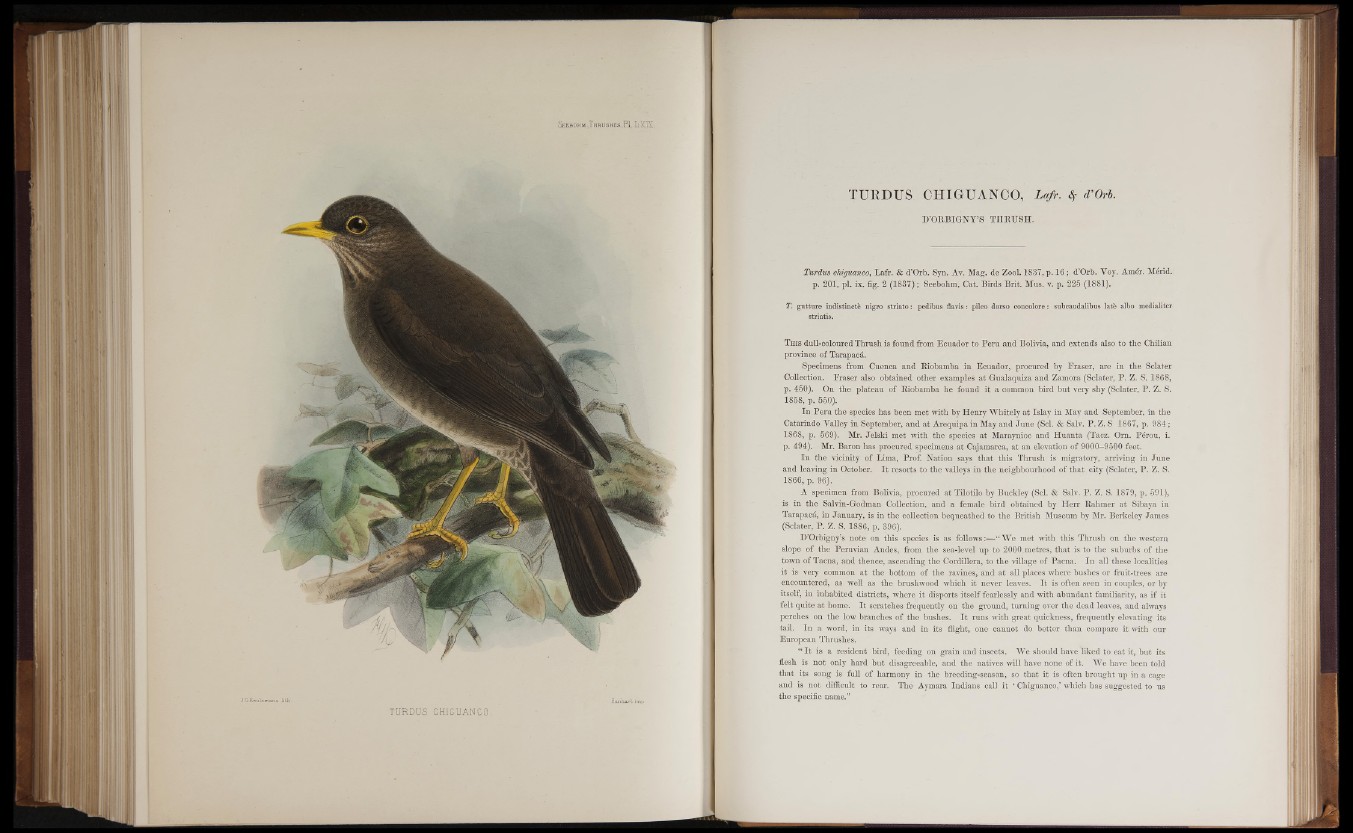
TURDUS CHIGUANCO, Lafr. 4- d'Orb.
D’ORBIGNY’S THRUSH.
Turdus chiguanco, Lafr. & d’Orb. Syn. Av. Mag. de Zool. 1837, p. 16; d’Orb. Voy. Amer. Merid.
p. 201, pi. ix. fig. 2 (1837); Seebohm, Cat. Birds Brit. Mus. v. p. 225 (1881).
T. gutture indistincte nigro striato: pedibus flavis: pileo dorso con colore: subcaudalibus latb albo medialiter
striatis.
T his dull-coloured Thrush is found from Ecuador to Peru and Bolivia, and extends also to the Chilian
province of Tarapaca.
Specimens from Cuenca and Biobamba in Ecuador, procured by Fraser, are in the Sclater
Collection. Fraser also obtained other examples at Gualaquiza and Zamora (Sclater, P. Z. S. 1868,
p. 450). On the plateau of Biobamba he found it a common bird but very shy (Sclater, P. Z. S.
1858, p. 550).
In Peru the species has been met with by Henry Whitely at Islay in May and September, in the
Catarindo Valley in September, and at Arequipa in May and June (Scl. & Salv. P. Z. S 1867, p. 984 ;
1868, p. 569). Mr. Jelski met with the species at Maraynioc and Huanta (Tacz. Om. Perou, i.
p. 494). Mr. Baron has procured specimens at Cajamarca, at an elevation of 9000-9500 feet.
In the vicinity of Lima, Prof. Nation says that this Thrush is migratory, arriving in June
and leaving in October. It resorts to the valleys in the neighbourhood of that city (Sclater, P. Z. S.
1866, p. 96).
A specimen from Bolivia, procured at Tilotilo by Buckley (Scl. & Salv. P. Z. S. 1879, p. 591),
is in the Salvin-Godman Collection, and a female, bird obtained by Herr Bahmer at Sibaya in
Tarapaca, in January, is in the collection bequeathed to the British Museum by Mr. Berkeley James
(Sclater, P. Z. S. 1886, p. 396).
D’Orbigny’s note on this species is as follows:—“We met with this Thrush on the western
slope of the Peruvian Andes, from the sea-level up to 2000.metres, that is to the suburbs of the
town of Tacna, and thence, ascending the Cordillera, to the village of Pacna. In all these localities
it is very common at the bottom of the ravines, and at all places where bushes or fruit-trees are
encountered, as well as the brushwood which it never leaves. It is often seen in couples, or by
itself, in inhabited districts, where it disports itself fearlessly and with abundant familiarity, as if it
felt quite at home. It scratches frequently on the ground, turning over the dead leaves, and always
perches on the low branches of the bushes. It runs with great quickness, frequently elevating its
tail. In a word, in its ways and in its flight, one cannot do better than compare it with our
European Thrushes.
“ It is a resident bird, feeding on grain and insects. We should have liked to eat it, but its
flesh is not only hard but disagreeable, and the natives will have none of it. We have been told
that its song is full of harmony in the breeding-season, so that it is often brought up in a cage
and is not difficult to rear. The Aymara Indians call it ‘ Chiguanco,’ which has suggested to us
the specific name.”